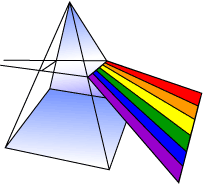Visible Light Spectrum: Difference between revisions
No edit summary |
|||
| Line 5: | Line 5: | ||
==Color Waves or Rays== | ==Color Waves or Rays== | ||
[[File:Roygbiv waves.gif|thumb|Color Wave Spectrum]] | |||
The higher the spectrum of frequency that exists within an electromagnetic wave, the shorter the actual waveform becomes. We may better understand this through the charts of the visible light spectrum that show most of the color waves that humans can see with their 3D eyes. | The higher the spectrum of frequency that exists within an electromagnetic wave, the shorter the actual waveform becomes. We may better understand this through the charts of the visible light spectrum that show most of the color waves that humans can see with their 3D eyes. | ||
The color wave spectrums at the base dimensions, such as the red (1D) and orange colors (2D), exist as a much longer electromagnetic wavelength than the higher frequencies that exist in the blue and indigo spectrum which have a shorter wavelength. | |||
The color wave spectrums at the base dimensions, such as the red (1D) and orange colors (2D), exist as a much longer electromagnetic wavelength than the higher frequencies that exist in the blue and indigo spectrum which have a shorter wavelength. | |||
==White Light Prism== | ==White Light Prism== | ||
[[File:Prism.gif|thumb|White Light Shines through Prism]] | [[File:Prism.gif|thumb|White Light Shines through Prism]] | ||
Revision as of 00:07, 1 March 2018
The visible spectrum is the portion of the electromagnetic spectrum that is visible to (can be detected by) the human eye. Electromagnetic radiation in this range of wavelengths is called visible light or simply light. A typical human eye will respond to wavelengths from about 390 to 700 nm.[1] In terms of frequency, this corresponds to a band in the vicinity of 430–790 THz. A light-adapted eye generally has its maximum sensitivity at around 555 nm (540 THz), in the green region of the optical spectrum (see: luminosity function). The spectrum does not, however, contain all the colors that the human eyes and brain can distinguish. Unsaturated colors such as pink, or purple variations such as magenta, are absent, for example, because they can be made only by a mix of multiple wavelengths. Colors containing only one wavelength are also called pure colors.
Visible light waves are the only electromagnetic waves we can see. We see these waves as the colors of the rainbow. Each color has a different wavelength. Red has the longest wavelength and violet has the shortest wavelength. When all the waves are seen together, they make white light.
Color Waves or Rays
The higher the spectrum of frequency that exists within an electromagnetic wave, the shorter the actual waveform becomes. We may better understand this through the charts of the visible light spectrum that show most of the color waves that humans can see with their 3D eyes.
The color wave spectrums at the base dimensions, such as the red (1D) and orange colors (2D), exist as a much longer electromagnetic wavelength than the higher frequencies that exist in the blue and indigo spectrum which have a shorter wavelength.
White Light Prism
When white light shines through a prism, the white light is broken apart into the colors of the Visible Light Spectrum. Water vapor in the atmosphere can also break apart wavelengths creating a rainbow.
The electromagnetic spectrum is the range of all possible frequencies of electromagnetic radiation. (Note: clearly many have not been discovered yet by mainstream science, nor new discoveries which compromise the controller program allowed to be made public.) The "electromagnetic spectrum" of an object has a different meaning, and is instead the characteristic distribution of electromagnetic radiation emitted or absorbed by that particular object.[1]
References




